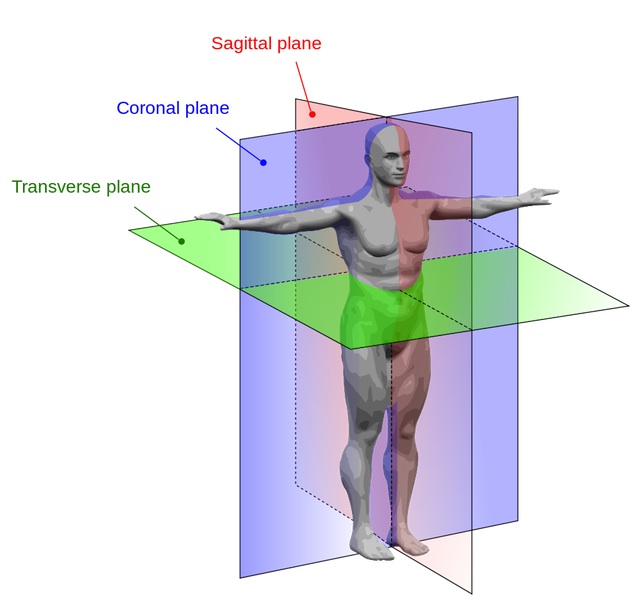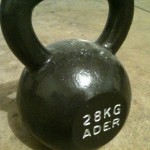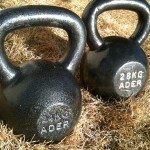Move in all planes of motion using all forms of primal movements. What the heck?
Yes, you can’t just sit at the computer typing endless emails, formatting 34-page summary reports, or laying out another power point presentation to stay healthy. Sure those use different parts of your brain, but your body isn’t even moving in a single plane. So … this article is going to expand on the two concepts that are especially important for us cube dwellers – movement.
When reviewing exercise programs there are two underlying aspects of movement to consider: planes and primality.
Planes of Motion
Okay get up – well, read this then get up and try this out. Think of your body and consider the different planes you can move in. There are three planes of motion. When you workout you need to make sure that you train in all planes of motion. So let’s get you moving through all three planes of motion to explain each one.
Step Back – Step Up – The Sagittal Plane
When you stand up, step back from your desk. Meet the sagittal plane of motion. Just that movement backwards was movement in the sagittal plane. It is the most common plane of movement in common exercises and typical movements in the day.
Any movement that moves you forward of backward is a movement in the sagittal plane.
Side Step Left – Arms Out To the Side – The Frontal Plane
Now as you step to the side (left or right) is a movement in the frontal plane, also called the coronal plane. Also lifting your arms up by swinging them up and out to the side is movement in the frontal plane as well.
Twist and Point – The Transverse Plane
Rotate your upper body so your outstretched arm is pointing toward your computer. Twisting – any movement that is moving, or preventing your body from moving, in rotation is the transverse plane.
This can be difficult to understand exercises that apply to this plane. That’s because many exercises in the transverse plane are stabilization exercises; so there isn’t visible movement in rotation.
Thanks for getting up and moving around. Wasn’t that micro-break worthwhile? I thought so.
Here is an image of the three planes of motion.

Got movement?
Image from Wikipedia – Human anatomy planes
Primal Movement Patterns
Paul Chek identified “Seven Primal Movement Patterns”. He felt we had lost track of how we were originally designed to move and function. He isolated seven core movements that all other movements are based. The seven primal movement patterns are:
- Squat
- Bend
- Lunge
- Push
- Pull
- Twist
- Gait
Planes and Primal Applied to Fitness
So now what? Just knowing the names doesn’t help. Why does this matter? Why not just go back to typing another email or work on that 34 -page summary report.
Tangent Ahead: Seriously, I overheard someone say there were working on a 34-page summary report. It got worse when I heard them say there was an executive summary report that was 8-pages long. Seriously?
In someways it was ironic that the conversation occurred because the person missed it while skimming emails.
Think about it. If the organization has too many emails, so people just skim them, do we really think executives will read an 8-page executive summary or others take time to read 34-page summary reports? My vote: not a chance that either will be read.
Sorry, now back to planes and primal movements. The reason this matters is variety to help avoid injuries.
Sure that’s a huge over-simplification, but think about it. Let’s say you do an old-school mega-gym workout. Something like this…
- Run on the treadmill
- Upper Body machines
- Narrow bench press
- Narrow row
- Bicep Curl (oh yeah, gun show)
- Tricep Extension
- Lower Body machines
- Leg extension
- Leg curl
- Abs Mat area in the corner
- Crunches
- Leg lifts
Now think about planes and primal. How many planes and primal movement did you use?
Planes: Sagittal
Primal Movements: Push, Pull, Gait
Ouch.
Now why does that matter? If you are like many of us cube dwellers, you live for weekend warrior adventures. I love to get out and enjoy all life has to offer. While you are out playing sports or just exploring most likely you will need to move side-to-side or twist. Those are two planes your training didn’t even touch. Without training your chance of injury goes up.
Change It Up – More Planes, More Primal
So instead change your workout up. When you workout think about moving in all three planes using all seven primal movements. Crank up the variety of planes and primal movements in your training.
One of the ways to train in more planes is to do Olympic lifts with offset weights. For example instead of working on a squat with equal loading from side to side; hold weight on just one side, or hold different amounts of weight on each side. By using offset weight you force your body to work in the frontal plane to keep from falling. With kettlebells many of the movement also require your body to resist twisting, so you are also working in the transverse plane.
A great way to get started with kettlebells is with the Turbulence Training Kettlebell Revolution program.

Grab a kettlebell and go through the following exercises:
- Swing
- Squat
- Lunge
- Clean-and-Press
- Windmill
- Deadlift
In that complex you’ve worked all three planes and all seven primal movements. By using this type of training you are preparing your body to move like you’ll be moving in your weekend adventures. Avoid injury, train smart by paying attention to planes and primal movements.







Want to discuss? Join the conversation CubeDwellerFitness's Facebook Page.